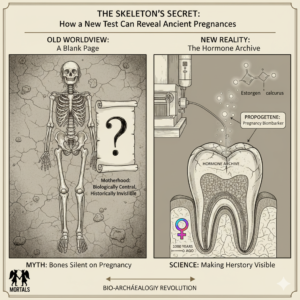The moment our ancestors stood up and walked on two legs was arguably the most significant single event in our evolutionary history. It freed our hands, changed our perspective, and set us on the path to becoming human. For decades, we have studied the fossilized bones of this transition. Now, a groundbreaking new study has for the first time identified the precise genetic recipe that made it possible. Researchers have discovered two tiny, ancient changes not to our genes, but to their “on-off” switches, that rotated our hips and set the stage for all of human evolution to follow.
The Information Box
Syllabus Connection:
- Paper 1: Chapter 1.4 (Human Evolution: Bipedalism), Chapter 1.6 (Fossil Hominins), Chapter 9.1 (Human Genetics), Chapter 12 (New perspectives: Evo-Devo)
Key Concepts/Tags:
- Bipedalism, Evolutionary Developmental Biology (Evo-Devo), Gene Regulation, Ilium, Pelvic Evolution, Human Adaptation, Evolutionary Trade-off
The Setting: Who, What, Where?
This case study is based on a landmark study published in Nature by a team of evolutionary biologists from Harvard University, including Gayani Senevirathne and Terence Capellini. Their research was not based on digging for fossils, but on comparative anatomy and genetics. They used high-resolution imaging and microscopic analysis to compare the way the pelvis develops from cartilage into bone in humans, chimpanzees, and mice, identifying the specific genetic activities responsible for the differences.
The Core Argument: Why This Study Matters
This research provides the first specific genetic mechanism for the evolution of bipedalism, reinforcing a central theory of modern evolution.
- Evolution by “Rewiring,” Not New Genes: This is the central discovery. The study powerfully reinforces the main principle of Evo-Devo: that major anatomical leaps often come from subtle changes in gene regulation—the timing and location of when existing genes are turned on or off—rather than from the evolution of entirely new genes.
- The Two “Tiny Tweaks” That Changed Everything:
- The Spatial Tweak (The 90-Degree Flip): In humans, cartilage-forming genes were turned on in a different location on the ilium (the big, flat hip bone). This caused the ilium to grow horizontally (sideways) instead of vertically, effectively rotating it 90 degrees. This crucial twist shifted our gluteal muscles from the back (where they are used for pushing forward on all fours) to the side, where they are now essential for maintaining balance on one foot at a time—the very definition of walking.
- The Temporal Tweak (The Delayed Hardening): The researchers found that in humans, the bone-forming genes in the pelvis are turned on later than in other primates. This simple delay allows the cartilage to grow sideways for a longer period, resulting in the short, wide, bowl-shaped pelvis that is the hallmark of human bipedalism, providing stability for our upright torso.
- The Origin of the Study: A Medical Question: Ironically, this fundamental evolutionary discovery was a byproduct of biomedical research funded to understand modern human hip disorders, like osteoarthritis.
The Anthropologist’s Gaze: A Critical Perspective
- The “Bipedalism-First” Hypothesis for Big Brains: The study offers a fascinating and profound knock-on hypothesis. The second tweak—delaying bone formation to create a wider pelvis for walking—also happened to create a roomier birth canal. The authors speculate that this change, made for the purposes of locomotion, may have been the crucial pre-adaptation or “practical facilitator” that, millions of “years later, allowed for the evolution of our famously large-brained babies, who require a wide canal to be born. This is a classic example of bio-cultural coevolution.
- The Evolutionary Trade-Off: This study is a perfect example of an evolutionary trade-off, a core concept in medical anthropology. The very genetic tweaks that gave us our bipedal advantage and (perhaps) our big brains also came at a cost. The new biomechanical stresses on this re-engineered pelvic structure are likely what make humans uniquely vulnerable to debilitating hip disorders like osteoarthritis. We are, in effect, suffering the consequences of our own evolutionary success.
- Beyond “Man the Hunter”: This research is purely biological, but it provides a genetic basis for a major shift in social behavior. As Carol Ward notes, this genetic change was critical for our ability to stand on one foot at a time. This adaptation is the physical foundation that freed the hands for tool use, carrying food, and infant care—the very behaviors that allowed our ancestors to move beyond a simple primate existence and into a new, culturally-rich hominin niche.
The Exam Angle: How to Use This in Your Mains Answer
- Types of Questions Where It can be Used:
- “Discuss the major anatomical and physiological changes associated with the evolution of bipedalism.”
- “What is Evolutionary Developmental Biology (Evo-Devo) and what is its significance in understanding human evolution?”
- “What do you understand by ‘evolutionary trade-offs’? Discuss with reference to human evolution.”
- Model Integration:
- On Bipedalism: “Recent genetic research has revealed the precise mechanism for our bipedal pelvis. It wasn’t new genes, but two ‘tweaks’ in gene regulation: a spatial change that flipped the ilium 90 degrees to reposition our gluteal muscles for balance, and a temporal change that delayed bone formation to create our wide, bowl-shaped pelvis.”
- On Evo-Devo: “The evolution of the human pelvis is a prime example of Evo-Devo. A 2025 study in ‘Nature’ showed that a simple shift in the timing and location of existing gene activity—not the creation of new genes—was responsible for the complex anatomical changes in the ilium that made upright walking possible.”
- On Evolutionary Trade-Offs (Medical Anthro): “Our evolutionary adaptations often come with trade-offs. The same genetic changes that provided humans with a stable, wide pelvis for bipedalism have also been linked to a higher vulnerability for hip disorders like osteoarthritis, which is far more common in humans than in other primates.”
Observer’s Take
This study is a remarkable piece of scientific detective work. It reminds us that the grandest, most defining leaps in evolution are not always the result of a dramatic, complex new invention, but sometimes of a simple, elegant tweak to the ancient instruction manual. The shift from quadruped to biped—the very change that freed our hands to build fires, create art, and hold our young—may have all started with a simple genetic instruction: “grow sideways, not up,” and “wait a little longer.” It’s a profound lesson in how evolution works as a thrifty tinkerer, not a grand engineer, and how a solution to one problem (walking) can accidentally open the door for a completely new future (bigger brains).
Source
- Title: The evolution of hominin bipedalism in two steps
- Authors: G. Senevirathne et al.
- Publication: Nature (Vol. 645, September 25, 2025)
- News Source: Science News





